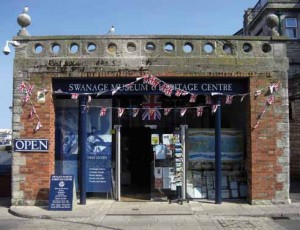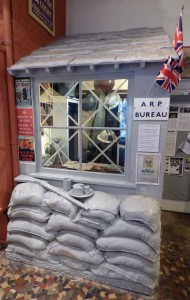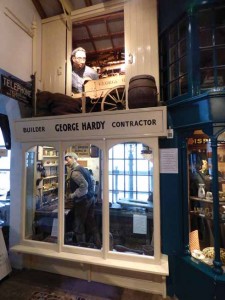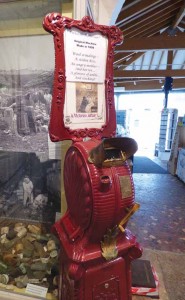Born in a barn – Swanage museum
Swanage Museum & Heritage Centre has come a long way in the last ten years, as Nick Churchill reports
Published in October ’15
In 2005 when Swanage’s Tithe Barn Museum was driven out of its home by a rotten roof it couldn’t afford to repair and merged with the Heritage Centre in The Square, little could the team of local history enthusiasts have known that a decade later visitor numbers would have grown twenty-fold.
It’s a remarkable achievement for the volunteer-run museum that is now split across three sites – the public-facing Museum and Heritage Centre, the Local Studies Centre at Marine Villas on the Pier and the climate-controlled storage facility it rents in a local industrial estate.
‘Until earlier this year we had the items that weren’t on display stored at Belle Vue Farm by kind permission of the farmer Ian Killick, but after a fire there he needed the barn back so we had to move out,’ explains local historian and the museum’s curator David Haysom. ‘Now we have some of the collections on the industrial estate; the paper archives, newspapers and photographs at the Local Studies Centre and the rest of them on display in the museum itself. We’re very satisfied with how things have turned out ten years after we had to move.’
The old Tithe Barn Museum, while charmingly idiosyncratic, was always a bit of a mystery to locals and visitors alike. Notoriously difficult to find it suffered from bad signposting outside, under-used space inside and, above it all, a roof that leaked like a sieve.
‘We had about 3000 visitors a year, which was a major factor in being refused Lottery funding to get the roof repaired – they said we had too few visitors to warrant a grant,’ says David. ‘However, they said they would support us if we moved to a better location. Around that time Purbeck District Council asked us if we could make the museum work in the space at the back of the Heritage Centre in the Square that was being used to project a film about Swanage. We thought long and hard and realised it was a viable proposition, said we’d like to give it a go and were given from Christmas to Easter to make it happen, helped by Lottery funding secured through the efforts of Jo Bowry at Purbeck District Council and the County Museums Adviser, David Tucker.’
The combined Museum and Heritage Centre opened in time for Easter 2006 and has been going from strength to strength ever since. The museum can now bank on at least 50,000 visitors a year.
‘One year we topped 60,000,’ David declares, with obvious pride. ‘We’re quite weather-dependent here – when it rains people love an indoor attraction, particularly one that’s free admission. So numbers were down last year when we had that incredible summer, but the weather has been more changeable this year so we’re up again. Some years the weather is barely recognisable as summer, that’s when we’re busiest.’
Through the summer months until the end of October the museum opens every day, then carries on at weekends only through November and December before closing from January until Easter.
‘It gives us chance to do maintenance work – the bricks on that outside wall on the sea side get so wet you can almost wring them out so they have to be treated, sealed and painted on the inside of the building every year.’
Five years ago the museum volunteers took on the running of the main counter and shop as the district council could no longer afford to run the Heritage Centre with paid staff. In return it now keeps the retail profits and donations to the museum.
‘We also receive donations from answering local and family history enquiries using the Local Studies Centre, which is an important part of our annual income. Two of our members, Dave and Jacqui Forster basically took on the shop, streamlining the stock and commissioning some souvenir items specifically for the museum.’
Such ingenuity and nouse are typical of the whole operation. Before the grand reopening a decade ago the then Swanage Museum chairman John Page put his considerable building and engineering skills to meticulously effective use constructing the shop windows and frontages from mostly recycled materials through which much of the town’s history is told in displays arranged and annotated by David Haysom.
‘It was a lot of work to get it all done in about three months, but we made it,’ recalls the curator. ‘Poole Museum was having a refurbishment and offered us sections of their former period street scene and a number of their old prop dummies for the displays. So our ARP warden was an Iron Age man in his previous role – one of our members had a background in hairdressing so gave him a short back and sides and he looks the part now. We’ve got a couple of former smugglers upstairs, the man in the builder’s yard used to be a clay worker and the woman leaning out of the chemist’s window, she used to be Cockle Kate from old Poole who, let’s just say, enjoyed something of a colourful reputation.’*
More recently, another member, Bob Field, had a yen to catalogue and research the artists whose work had been inspired by visits to Swanage and the surrounding area. He wanted to provide biographical information and copies of the work to take the information that can be gleaned from Carlotta Barrow’s very popular Swanage Seen art trail to the next level.
‘He started off with a couple of files and a few names and the project is up to more than 700 artists now. We get a lot of interest in these files from visitors to the museum,’ says David.
The museum offers a methodical and engaging take on the history of Swanage, from the Jurassic age up until the late 20th century. At its heart is a nostalgic stroll past shop fronts of the last 150 years including Lloyds the dispensing chemists, Hardy’s builders yard and the ARP bureau. There are the town’s great builders – John Mowlem, George Burt and William Masters Hardy – but also the social history of the stone quarries and the promotion of Swanage as a health resort where middle and upper class Victorians could take the waters. There’s even a What the Butler Saw machine for those in need of a little titillation, Edwardian style!
Unsurprisingly the two great wars of the 20th century loom large over the museum and for all that some claim the lady leaning out of the chemist’s window is the spit of the woman who once ran it she is in fact raising the alarm as Luftwaffe bombers appear on the horizon – their silhouettes are painted on the wall behind her.
‘By January 1944 Swanage had had more air raid alerts than London,’ says David. ‘It was on the flight path for bombing raids up country and when the planes came back over if they had munitions left they would drop their bombs on south coast towns like Swanage before crossing the Channel again. Most of the damage to the town was done in about eight raids; around 20 people were killed and many more were injured.
‘In October 1940 they dropped a time bomb in a field near Steer Road. Many houses had to be evacuated and it finally exploded 71 hours later. We have a piece of this bomb on display in the museum with other bomb fragments, all found by Hardy’s builders after the air raids.’
Last year, as part of the centenary commemoration of the outbreak of World War 1 museum volunteer John Patrick researched the lives of the fallen whose names are on Swanage War Memorial.
‘He was able to correct and update some of the details that had been gathered for the national Roll of Honour project. This summer we’ve had an art exhibition, but during the winter the permanent history panels will be on display again telling the story from the 19th century up until World War 2. Our World War 1 display will also be on show again in the front window of the museum.’

As well as the museum section beyond the arch, the surprisingly capacious building also holds the heritage the heritage centre and shop
While the museum’s 35 or so active volunteers clearly manage very well, they never turn anyone away who finds they can spare a few hours to become a counter helper or research enquiries and like many such organisations would dearly love more younger volunteers.
‘But we’re in good shape,’ says David. ‘The original five-year lease had the option of a sixth year that we’ll take up and we’re keen to negotiate a new lease after that. All the indications are that the district council will continue to be as supportive as it always has been so we’ll mark our tenth anniversary by looking forward to the next ten years and beyond.’ ◗
*Cockle Kate was a notorious drunkard and prostitute in Poole. Born in 1878, Kate Elizabeth Egg used her father’s name Cartridge for most of her life and also found work as a fish seller and in a twine factory. She died in 1951.
INFORMATION
Swanage Museum and Heritage Centre
The Square, Swanage, BH19 2LJ
01929 421427
❱ www.swanagemuseum.co.uk
credit: pics 1,3 and 5 David Haysom






